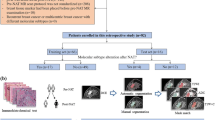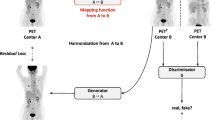Abstract
Purpose
Low-energy virtual monochromatic images (VMIs) derived from dual-energy computed tomography (DECT) systems improve lesion conspicuity of head and neck cancer over single-energy CT (SECT). However, DECT systems are installed in a limited number of facilities; thus, only a few facilities benefit from VMIs. In this work, we present a deep learning (DL) architecture suitable for generating pseudo low-energy VMIs of head and neck cancers for facilities that employ SECT imaging.
Methods
We retrospectively analyzed 115 patients with head and neck cancers who underwent contrast enhanced DECT. VMIs at 70 and 50 keV were used as the input and ground truth (GT), respectively. We divided them into two datasets: for DL (104 patients) and for inference with SECT (11 patients). We compared four DL architectures: U-Net, DenseNet-based, and two ResNet-based models. Pseudo VMIs at 50 keV (pVMI50keV) were compared with the GT in terms of the mean absolute error (MAE) of Hounsfield unit (HU) values, peak signal-to-noise ratio (PSNR), and structural similarity (SSIM). The HU values for tumors, vessels, parotid glands, muscle, fat, and bone were evaluated. pVMI50keV were generated from actual SECT images and the HU values were evaluated.
Results
U-Net produced the lowest MAE (13.32 ± 2.20 HU) and highest PSNR (47.03 ± 2.33 dB) and SSIM (0.9965 ± 0.0009), with statistically significant differences (P < 0.001). The HU evaluation showed good agreement between the GT and U-Net. U-Net produced the smallest absolute HU difference for the tumor, at < 5.0 HU.
Conclusion
Quantitative comparisons of physical parameters demonstrated that the proposed U-Net could generate high accuracy pVMI50keV in a shorter time compared with the established DL architectures. Although further evaluation on diagnostic accuracy is required, our method can help obtain low-energy VMI from SECT images without DECT systems.







Similar content being viewed by others
References
Matsumoto K, Jinzaki M, Tanami Y, Ueno A, Yamada M, Kuribayashi S (2011) Virtual monochromatic spectral imaging with fast kilovoltage switching: improved image quality as compared with that obtained with conventional 120-kVp CT. Radiology 259(1):257–262
Ohira S, Yagi M, Iramina H, Karino T, Washio H, Ueda Y, Miyazaki M, Koizumi M, Teshima T (2018) Treatment planning based on water density image generated using dual-energy computed tomography for pancreatic cancer with contrast-enhancing agent: Phantom and clinical study. Med Phys 45(11):5208–5217
Bamberg F, Dierks A, Nikolaou K, Reiser MF, Becker CR, Johnson TR (2011) Metal artifact reduction by dual energy computed tomography using monoenergetic extrapolation. Eur Radiol 21(7):1424–1429
Hakvoort ET, Wellenberg RHH, Streekstra GJ (2020) Quantifying near metal visibility using dual energy computed tomography and iterative metal artifact reduction in a fracture phantom. Phys Med 69:9–18
Forghani R, Kelly H, Yu E, Belair M, Létourneau-Guillon L, Le H, Proulx F, Ong T, Tan X, Curtin HD, Levental M (2017) Low-energy virtual monochromatic dual-energy computed tomography images for the evaluation of head and neck squamous cell carcinoma: a study of tumor visibility compared with single-energy computed tomography and user acceptance. J Comput Assist Tomogr 41(4):565–571
Lam S, Gupta R, Levental M, Yu E, Curtin HD, Forghani R (2015) Optimal virtual monochromatic images for evaluation of normal tissues and head and neck cancer using dual-energy CT. AJNR Am J Neuroradiol 36(8):1518–1524
Kraft M, Ibrahim M, Spector M, Forghani R, Srinivasan A (2018) Comparison of virtual monochromatic series, iodine overlay maps, and single energy CT equivalent images in head and neck cancer conspicuity. Clin Imaging 48:26–31
Ronneberger O, Fischer P, Brox T (2015) U-Net: Convolutional Networks for Biomedical Image Segmentation. In: Medical Image Computing and Computer Assisted Intervention (MICCAI)
Zhao W, Lv T, Lee R, Chen Y, Xing L (2020) Obtaining dual-energy computed tomography (CT) information from a single-energy CT image for quantitative imaging analysis of living subjects by using deep learning. Pac Symp Biocomput 25:139–148
He K, Zhang X, Ren S, Sun J (2016) Deep Residual Learning for Image Recognition. In: 2016 IEEE Conference on Computer Vision and Pattern Recognition (CVPR), pp 770–778
Cong W, Xi Y, Fitzgerald P, De Man B, Wang G (2020) Virtual monoenergetic CT imaging via deep learning. Patterns 1(8):100128
Goodfellow IJ, Pouget-Abadie J, Mirza M, Xu B, Warde-Farley D, Ozair S, Courville A, Bengio Y (2014) Generative adversarial nets. In: Advances in neural information processing systems, pp 2672–2680
Isola P, Zhu J-Y, Zhou T, Efros AA (2017) Image-to-Image Translation with Conditional Adversarial Networks. In: IEEE Conference on computer vision and pattern recognition (CVPR) pp 5967–5976
Funama Y, Oda S, Kidoh M, Nagayama Y, Goto M, Sakabe D, Nakaura T (2021) Conditional generative adversarial networks to generate pseudo low monoenergetic CT image from a single-tube voltage CT scanner. Phys Med 83:46–51
Ohira S, Koike Y, Akino Y, Kanayama N, Wada K, Ueda Y, Masaoka A, Washio H, Miyazaki M, Koizumi M, Ogawa K, Teshima T (2021) Improvement of image quality for pancreatic cancer using deep learning-generated virtual monochromatic images: Comparison with single-energy computed tomography. Phys Med 85:8–14
Huang G, Liu Z, Maaten LVD, Weinberger KQ (2017) Densely Connected Convolutional. Networks. https://doi.org/10.1109/CVPR.2017.243
Zhang K, Zuo W, Chen Y, Meng D, Zhang L (2017) Beyond a gaussian denoiser: residual learning of deep CNN for image denoising. IEEE Trans Image Process 26(7):3142–3155
Karaoğlu O, Bilge HŞ, Uluer İ (2021) Removal of speckle noises from ultrasound images using five different deep learning networks. Eng Sci Technol Int J. https://doi.org/10.1016/j.jestch.2021.06.010
Wang Z, Bovik AC, Sheikh HR, Simoncelli EP (2004) Image quality assessment: from error visibility to structural similarity. IEEE Trans Image Process 13(4):600–612
Albrecht MH, Scholtz JE, Kraft J, Bauer RW, Kaup M, Dewes P, Bucher AM, Burck I, Wagenblast J, Lehnert T, Kerl JM, Vogl TJ, Wichmann JL (2015) Assessment of an advanced monoenergetic reconstruction technique in dual-energy computed tomography of head and neck cancer. Eur Radiol 25(8):2493–2501
Ng SP, Cardenas CE, Elhalawani H, Pollard C 3rd, Elgohari B, Fang P, Meheissen M, Guha-Thakurta N, Bahig H, Johnson JM, Kamal M, Garden AS, Reddy JP, Su SY, Ferrarotto R, Frank SJ, Brandon Gunn G, Moreno AC, Rosenthal DI, Fuller CD, Phan J (2020) Comparison of tumor delineation using dual energy computed tomography versus magnetic resonance imaging in head and neck cancer re-irradiation cases. Phys Imaging Radiat Oncol 14:1–5
Nguyen D, Jia X, Sher D, Lin MH, Iqbal Z, Liu H, Jiang S (2019) 3D radiotherapy dose prediction on head and neck cancer patients with a hierarchically densely connected U-net deep learning architecture. Phys Med Biol 64(6):065020
Yi X, Walia E, Babyn P (2019) Generative adversarial network in medical imaging: A review. Med Image Anal 58:101552
Funding
This work was supported by JSPS KAKENHI [Grant Nos. 20K16742 and 21K07742].
Author information
Authors and Affiliations
Corresponding author
Ethics declarations
Conflict of interest
The authors declare that they have no conflict of interest.
Ethics approval
This study was approved by the ethical committee of Osaka International Cancer Institute (No. 20078).
Informed consent
Informed consent was obtained from all individual participants included in the study.
Additional information
Publisher's Note
Springer Nature remains neutral with regard to jurisdictional claims in published maps and institutional affiliations.
Rights and permissions
About this article
Cite this article
Koike, Y., Ohira, S., Teraoka, Y. et al. Pseudo low-energy monochromatic imaging of head and neck cancers: Deep learning image reconstruction with dual-energy CT. Int J CARS 17, 1271–1279 (2022). https://doi.org/10.1007/s11548-022-02627-x
Received:
Accepted:
Published:
Issue Date:
DOI: https://doi.org/10.1007/s11548-022-02627-x




